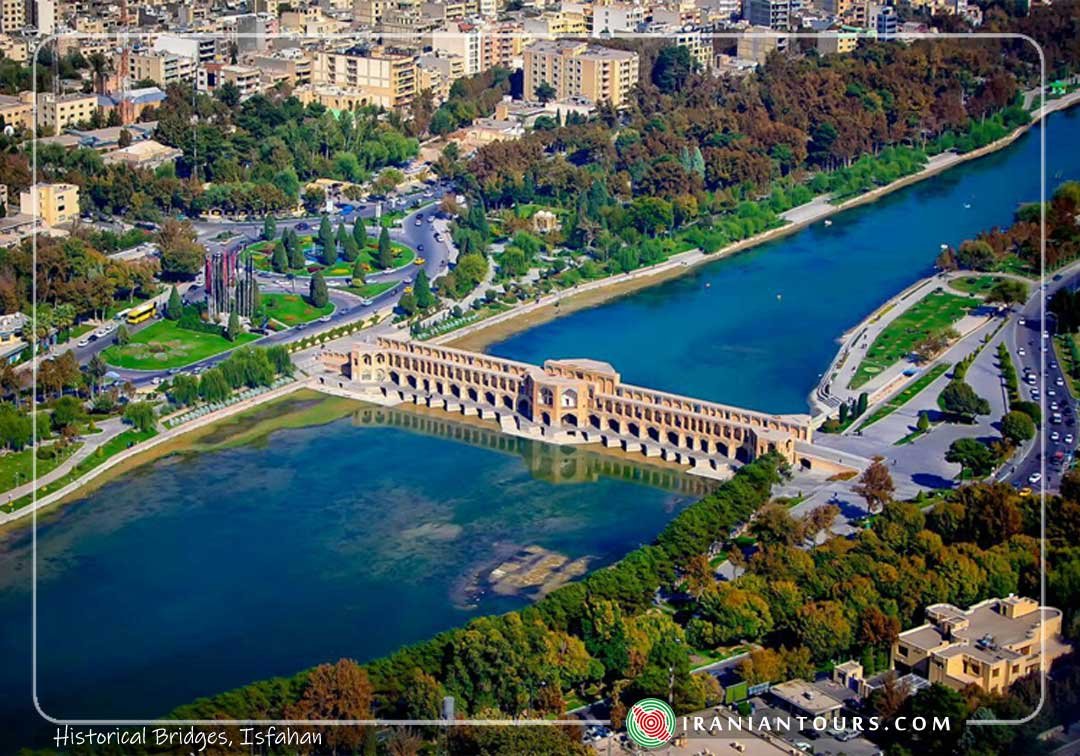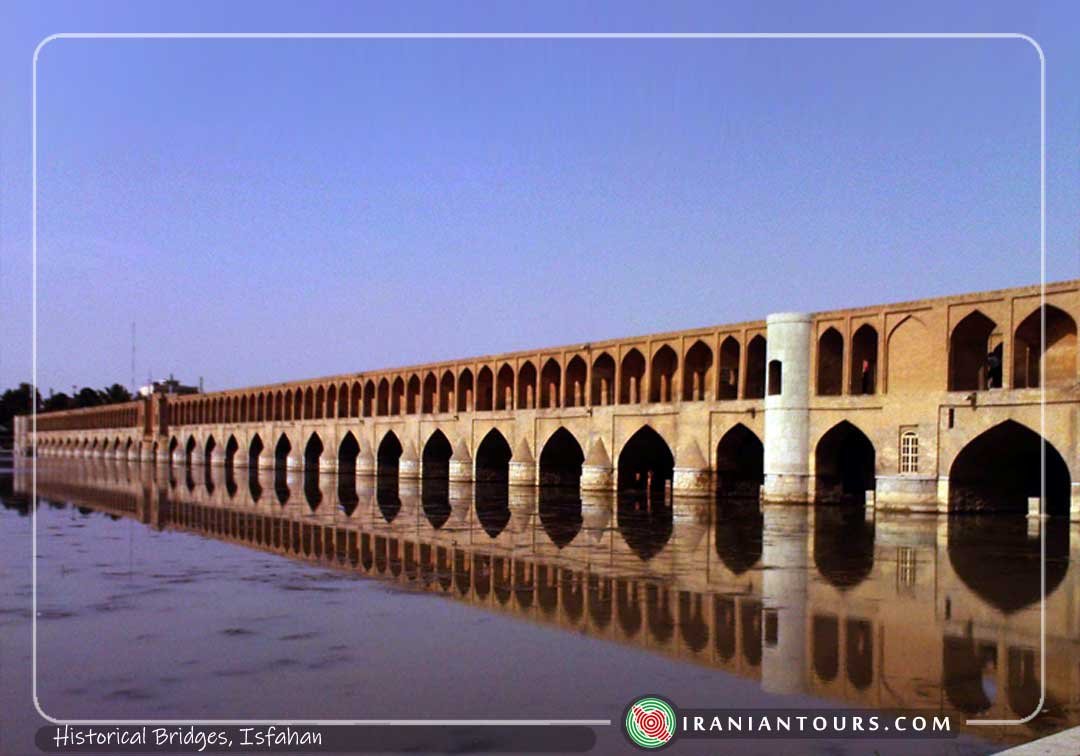Historical Bridges
There are a number of historical bridges spanning Zayandehrud river, connecting southern and northern parts of Isfahan. Most of them were constructed during Safavid era.
Here is some info about them :
Khaju Bridge
The Khaju Bridge is one of the historical bridges on the Zayanderud, the largest river of the Iranian Plateau, in Isfahan, Iran. Serving as both a bridge and a weir, it links the Khaju quarter on the north bank with the Zoroastrian quarter across the Zayanderud. It also served a primary function as a building and a place for public meetings It has been described as the city’s finest bridge.
The mausoleum of Arthur Pope and his wife Phyllis Ackerman is situated nearby.
The Khaju Bridge was built around 1650, under the reign of Abbas II, the seventh Safavid king (shah) of Iran, on the foundations of an older bridge. The existing inscriptions suggest that the bridge was repaired in 1873. There is a pavilion located in the centre of the structure, inside which Abbas II would have once sat, admiring the view. Today, remnants of a stone seat are all that is left of the king’s chair.
In the words of Arthur Pope and Jean Chardin, Khaju is “the culminating monument of Persian bridge architecture and one of the most interesting bridges extant … where the whole has rhythm and dignity and combines in the happiest consistency, utility, beauty, and recreation.
The bridge has 23 arches and is 133 meters long and 12 meters wide. It was originally decorated with tilework and paintings and served as a teahouse. The pass way of the bridge is made of bricks and stones with 21 larger and 26 smaller inlet and outlet channels and is 7.5 meters wide. The pieces of stone used in the bridge are over 2 meters long, and the distance between every channel and the ceiling base is 21 meters.
There are several sluice gates under the archways, through which the water flow of the Zayanderud is regulated. When the sluice gates are closed, the water level behind the bridge is raised to facilitate the irrigation of the many gardens along the river upstream of the bridge. On the upper level of the bridge, the main central aisle was utilized by horses and carts, and the vaulted paths on either side by pedestrians. Octagonal pavilions in the centre of the bridge on both the down and the upstream sides provide vantage points for the remarkable views. The lower level of the bridge may be accessed by pedestrians and remains a popular shady place for relaxing.
Iranian architects have raised concerns about the damage inflicted on the bridge during recent “improvement program” renovations, citing, among other problems, the destruction of the original stepped base of the bridge, the alterations made to the riverbed, and the removal of the Safavid inscribed stone blocks from the bridge.
Siosepol Bridge
The Allahverdi Khan Bridge, popularly known as Si-o-se-pol, literally the bridge of ‘thirty-three spans’ is the largest of the eleven historical bridges on the Zayanderud, the largest river of the Iranian Plateau, in Isfahan, Iran.
The bridge was built in the early 17th century to serve as both a bridge and a dam. It is a popular recreational gathering place and is one of the most famous examples of Iran’s Safavid architecture.
Si-o-se-pol was built between 1599 and 1602, under the reign of Abbas I, the fifth Safavid king (shah) of Iran. It was constructed under the supervision of Allahverdi Khan Undiladze, the commander-in-chief of the armies, who was of Georgian origin and was also named after him. The bridge served particularly as a connection between the mansions of the elite, as well as a link to the city’s vital Armenian neighbourhood of New Julfa.
he bridge has a total length of 297.76 metres (976.9 ft) and a total width of 14.75 metres (48.4 ft). It is a vaulted arch bridge consisting of two superimposed rows of 33 arches, from whence its popular name of Si-o-se-pol comes, and is made of stone. The longest span is about 5.60 metres (18.4 ft). The interior of Si-o-se-pol was originally decorated with paintings, which were often described by travellers as erotic.
There is a larger base plank at the start of the bridge, under which the Zayanderud flows, supporting a tea house, which is nowadays abandoned.
Shahrestan Bridge
The Shahrestan bridge is the oldest bridge on the Zayandeh River in Iran. The foundations date back to the Sasanian era (3rd to 7th century C.E.), but the top was renovated twice, first in the 10th century by the Buyids, then during the 11th century during the Seljuk period. Nevertheless, the architectural style is entirely Sassanian.
The bridge consists of two parabolas. The vertical parabola ensures that the middle of the bridge is its highest point. The horizontal parabola produces a bend to the west, strengthening it against the flow of the river. The bridge is 107.8 metres long and an average of 5.2 metres wide. It has two tiers of pointed arches, thirteen large ones spanning the river itself, and eight smaller ones that nest between them. The purpose of the latter is to quicken the flow of water during floods, taking pressure off the structure. The Zayandeh River has recently been diverted about 100 meters away from the bridge towards the south, leaving an artificial lake around the bridge to protect it from further damage.
Choobi Bridge
Joui Bridge also called the Choobi Bridge, is a bridge in Isfahan, Iran. It was built in 1665, during the Safavid era.
The Joui Bridge is located between Khaju and Ferdowsi bridges. It is 147 meters long and 4 meters wide, with 21 arches. It was built during the reign of Shah Abbas II to irrigate and connect the king’s gardens on both sides of the river. The bridge and the two parlours within were for the exclusive use of the shah and his courtiers. Nowadays the parlours are being used as tea houses.
Marnan Bridge
Marnan Bridge is a historical bridge in Isfahan, Iran. The current structure of the bridge dates back to the Safavid era, but its foundations are older and possibly as old as the Shahrestan bridge, which dates back to the Sasanian era.












